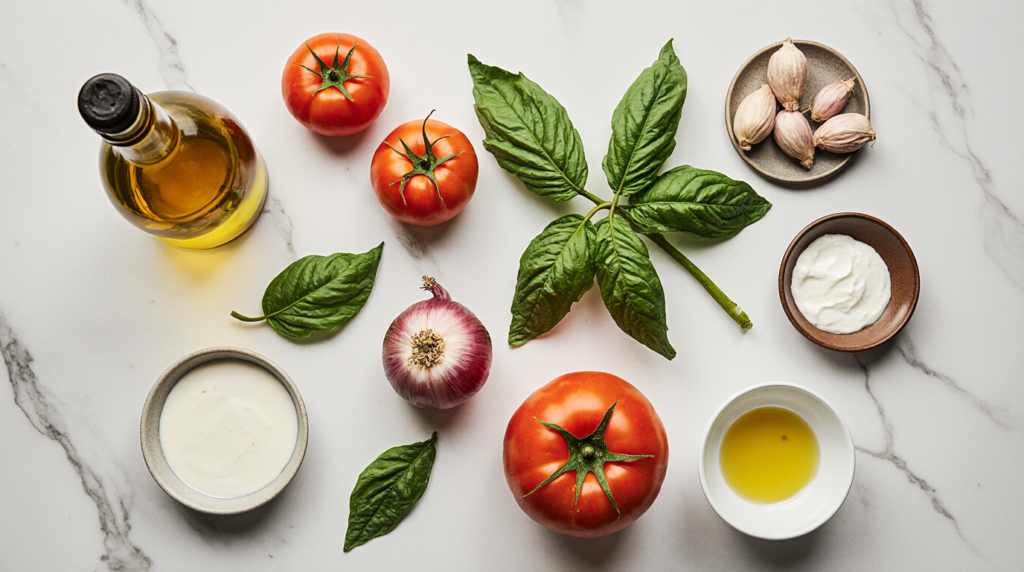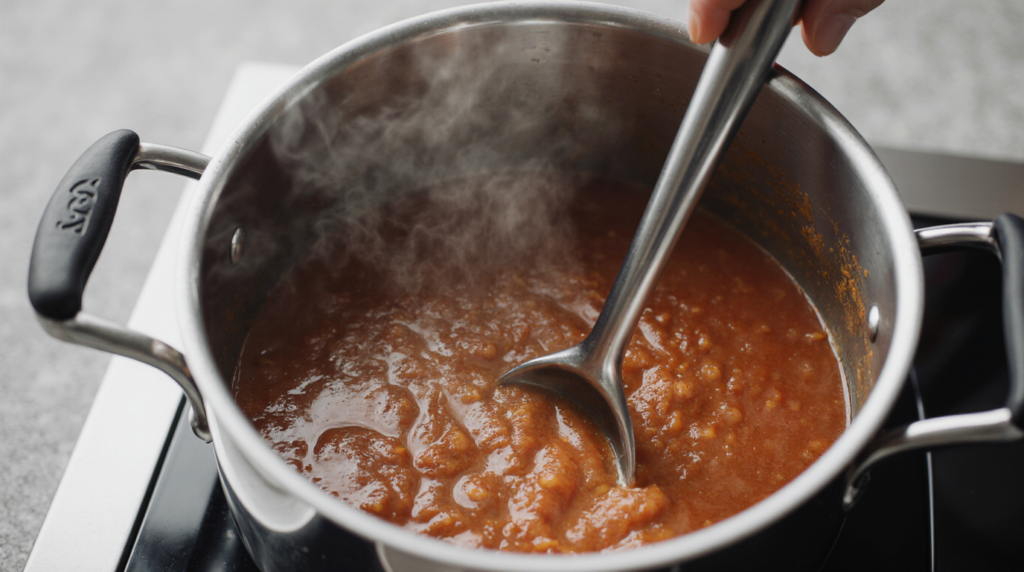Creamy Tomato Basil Soup – Rich, Smooth & Perfect Comfort Food
I have always been a fan of comfort food, and Creamy Tomato Basil Soup is one of my top favorites. This delicious soup is a staple in many American households, and for good reason. Its rich and smooth texture makes it the perfect remedy for a chilly day or a cozy night in.
As a comfort food classic, this soup has been a long-standing favorite, and its significance in American cuisine cannot be overstated. The combination of flavors and textures creates a truly satisfying experience.
Key Takeaways
- The importance of Creamy Tomato Basil Soup in American cuisine.
- Its rich and smooth texture as a comfort food.
- Why it’s a staple in many households.
- The role of basil in enhancing the flavor.
- Tips for making the perfect Creamy Tomato Basil Soup.
The Comforting Appeal of Tomato Soup
As a comfort food, tomato soup holds a special place in the hearts of many, particularly in American cuisine where it’s often associated with warmth and nostalgia. This beloved dish has a way of transporting us back to a simpler time, evoking memories of childhood and home.

A Timeless Classic in American Cuisine
Tomato soup has been a staple in American cuisine for generations, its enduring popularity a testament to its comforting appeal. It’s a dish that has been passed down through families, with each household adding its own twist to the recipe. Whether served with a grilled cheese sandwich or enjoyed on its own, tomato soup remains a timeless classic that continues to warm hearts and bellies alike.
The versatility of tomato soup is part of its charm, allowing it to be adapted to various tastes and dietary preferences. From creamy versions loaded with fresh basil to clear broths infused with the subtle sweetness of tomatoes, there’s a tomato soup to suit every palate.
My Personal Connection to Tomato Soup
For me, tomato soup is more than just a meal; it’s a connection to my past. Growing up, my grandmother would make it for me whenever I was feeling under the weather, and the memory of those moments has stayed with me. There’s something about the combination of tender tomatoes, fragrant basil, and a hint of cream that feels like a warm hug in a bowl.
This personal connection is what drives my passion for making the perfect tomato soup. It’s about recreating those comforting feelings and sharing them with others. Whether it’s through a traditional recipe or a modern twist, the essence of tomato soup remains the same – a comforting, nourishing dish that brings people together.


The History of Tomato Soup in American Culture
From its early days as an exotic fruit to its current status as a pantry staple, tomato soup has undergone a significant transformation in American culture. This evolution is a testament to the adaptability and creativity of American cuisine.
From Exotic Fruit to Pantry Staple
Tomatoes were first introduced to America in the 18th century, and initially, they were met with skepticism due to their bright red color and unfamiliar taste. However, as trade and cultural exchange increased, tomatoes became more accepted, and by the late 19th century, they had become a staple ingredient in many American kitchens.
The rise of canned tomatoes in the early 20th century further accelerated the popularity of tomato soup. Companies like Campbell’s pioneered the production of condensed soups, making it easy for home cooks to prepare a quick and delicious meal.
The Evolution of Creamy Tomato Basil Soup
The modern version of creamy tomato basil soup is a more recent development, influenced by the growing interest in fresh herbs and gourmet cooking. The addition of basil to tomato soup adds a layer of complexity and freshness, elevating it from a simple comfort food to a sophisticated dish.
To illustrate the evolution of tomato soup, let’s look at some key milestones:
| Year | Event | Impact |
|---|---|---|
| 18th century | Tomatoes introduced to America | Initial skepticism, but eventual acceptance |
| Late 19th century | Tomatoes become a staple ingredient | Increased use in cooking, including soups |
| Early 20th century | Rise of canned tomatoes | Convenience and accessibility for home cooks |
| Late 20th century | Gourmet cooking and fresh herbs gain popularity | Emergence of creamy tomato basil soup as a sophisticated dish |
As we can see, the history of tomato soup in American culture is a rich and complex one, influenced by various factors and culinary trends.
Nutritional Benefits of Tomatoes and Basil
Tomatoes and basil, the core components of our Creamy Tomato Basil Soup, offer a multitude of health benefits. These ingredients not only enhance the flavor but also significantly boost the nutritional profile of the soup.
Tomatoes: Packed with Lycopene and Antioxidants
Tomatoes are rich in lycopene, a powerful antioxidant that has been linked to reduced risks of certain cancers and heart disease. Lycopene’s antioxidant properties help protect cells from damage, contributing to overall health. Additionally, tomatoes are a good source of vitamins C and K, potassium, and folate, making them a nutritious addition to our soup.
Basil: More Than Just Flavor
Basil is not just a flavorful herb; it’s also packed with nutrients. It contains vitamins A, C, and K, and is a good source of minerals like potassium and magnesium. Basil also has anti-inflammatory properties and antioxidants that can help protect against certain diseases. The combination of basil with tomatoes in our Creamy Tomato Basil Soup creates a dish that is both delicious and nutritious.
Essential Ingredients for the Perfect Creamy Tomato Basil Soup
Creating a rich and flavorful Creamy Tomato Basil Soup begins with choosing the finest ingredients. The quality of the soup is directly related to the quality of its components, making the selection process crucial.
Selecting the Best Tomatoes
The type of tomatoes used can significantly impact the flavor and texture of the soup. There are two primary options: fresh tomatoes and canned tomatoes.
Fresh Tomato Varieties
For a fresh, vibrant flavor, using ripe, fresh tomatoes is ideal. Varieties like Brandywine or Cherry Tomatoes are excellent choices due to their rich flavor and tender texture.
Canned Tomato Options
Canned tomatoes offer convenience and consistency. San Marzano tomatoes are highly recommended for their sweet-tart flavor and low acidity, making them perfect for soups.
Fresh vs. Dried Basil: What Works Best
Basil is a crucial ingredient in Creamy Tomato Basil Soup, and the choice between fresh and dried basil can affect the flavor profile. Fresh basil provides a bright, herbaceous note, while dried basil offers a more concentrated flavor.
The Supporting Cast: Aromatics and Dairy
Aromatics and dairy products play a vital role in enhancing the soup’s flavor and texture.
Onions, Garlic, and Herbs
Onions and garlic are sautéed to create a flavorful base. Additional herbs like thyme or oregano can add depth to the soup.
Cream, Milk, and Alternatives
Cream or milk is used to achieve the desired creaminess. For those looking for dairy-free alternatives, options like coconut milk or almond milk can be used.
By carefully selecting these ingredients, you can create a Creamy Tomato Basil Soup that is both rich and flavorful.
Kitchen Equipment You’ll Need
Having the correct kitchen equipment is crucial for making a rich and creamy tomato basil soup. To prepare this comforting dish, you’ll need a few essential tools and appliances.
Essential Tools for Preparation
To start, you’ll need a large pot, preferably made of stainless steel or heavy-bottomed material, to sauté your aromatics and simmer your soup. A good chef’s knife is also indispensable for chopping fresh basil and tomatoes. Additionally, a cutting board provides a clean and stable surface for your prep work.
- A large, heavy-bottomed pot
- A sharp chef’s knife
- A sturdy cutting board
Blending Options for the Perfect Texture
To achieve the perfect creamy texture, you have a couple of blending options. An immersion blender allows you to blend the soup right in the pot, minimizing cleanup and reducing the risk of splashing hot soup. Alternatively, you can use a countertop blender to blend your soup in batches, ensuring a smooth consistency.
- Immersion blender for convenience
- Countertop blender for a smooth finish
Creamy Tomato Basil Soup Recipe
In this section, I’ll guide you through the steps to create a mouth-watering Creamy Tomato Basil Soup that’s perfect for any occasion.

Ingredient List and Measurements
To make this delicious soup, you’ll need the following ingredients:
| Ingredient | Quantity |
|---|---|
| Fresh tomatoes or canned crushed tomatoes | 2 cups |
| Fresh basil leaves | 1/4 cup chopped |
| Onion | 1 medium, diced |
| Garlic | 3 cloves, minced |
| Chicken or vegetable broth | 4 cups |
| Heavy cream or half-and-half | 1 cup |
| Olive oil | 2 tablespoons |
| Salt and pepper | To taste |
Preparation and Cooking Process
The preparation and cooking process involves several steps that are easy to follow.
Preparing the Base
Start by heating the olive oil in a large pot over medium heat. Add the diced onion and cook until it’s translucent, about 5 minutes. Then, add the minced garlic and cook for another minute, stirring constantly to prevent burning.
Simmering to Perfection
Next, add the chopped fresh tomatoes or canned crushed tomatoes, broth, salt, and pepper. Bring the mixture to a boil, then reduce the heat to low and simmer for 20-25 minutes, or until the flavors have melded together and the soup has thickened slightly.
Finishing Touches
Use an immersion blender to puree the soup until smooth, or allow it to cool and blend it in batches in a blender. Return the soup to the pot, add the chopped fresh basil and heavy cream or half-and-half, and stir to combine. Heat the soup over low heat until warmed through, then serve hot.
Techniques for Achieving the Perfect Consistency
Achieving the perfect consistency in Creamy Tomato Basil Soup is an art that requires precision and a few clever techniques. The texture of the soup can make or break the dining experience, and there are several methods to achieve the ideal balance.

Balancing Creaminess Without Heaviness
To balance creaminess without making the soup too heavy, it’s essential to use the right dairy products. Heavy cream can enrich the soup, but using it in excess can make it overly rich. A combination of heavy cream and milk or a lighter cream can provide the desired creaminess without the heaviness. Additionally, incorporating ingredients like potatoes or cashews can help thicken the soup naturally, reducing the need for excessive dairy.
| Ingredient | Function | Effect on Consistency |
|---|---|---|
| Heavy Cream | Adds richness | Increases creaminess |
| Milk | Lightens the texture | Reduces heaviness |
| Potatoes/Cashews | Natural thickeners | Thickens without added dairy |
Straining vs. Blending: Texture Considerations
The decision to strain or blend the soup depends on the desired texture. Blending the soup can create a smooth, uniform texture, while straining can remove excess pulp and achieve a cleaner consistency. For a Creamy Tomato Basil Soup, blending is often preferred to maintain the creamy texture. However, if a clearer soup is desired, straining after blending can be an effective approach.
Ultimately, achieving the perfect consistency involves a combination of the right ingredients and techniques. By understanding the roles of different components and how they affect the texture, you can create a Creamy Tomato Basil Soup that is both satisfying and refined.
Flavor Enhancers and Secret Ingredients
Elevating a simple Creamy Tomato Basil Soup to a gourmet experience involves more than just quality ingredients. It’s about understanding how to layer flavors and enhance the natural taste of the tomatoes and basil. In this section, we’ll explore some unexpected additions that can transform your soup.
Unexpected Additions That Elevate Your Soup
One of the most effective flavor enhancers is a pinch of red pepper flakes, which adds a subtle kick without overpowering the other ingredients. Another secret ingredient is a splash of balsamic vinegar, which deepens the flavor profile. Additionally, a sprinkle of nutritional yeast can provide a cheesy, nutty flavor without the need for dairy.
Experimenting with different combinations of these enhancers can help you find the perfect balance for your taste. For instance, adding a bit of smoked paprika can introduce a smoky depth, while a handful of fresh spinach stirred in at the end can add a burst of freshness.
Balancing Acidity and Sweetness
Achieving the right balance between acidity and sweetness is crucial for a harmonious flavor profile. Tomatoes naturally contain acidity, which can be enhanced by ingredients like lemon juice or vinegar. On the other hand, the sweetness comes from the tomatoes themselves, especially when they’re ripe, and from any added sugars or carrots. The key is to taste as you go and adjust accordingly.
For example, if your soup tastes too acidic, a small amount of sugar or a grated carrot can help neutralize it. Conversely, if it’s too sweet, a squeeze of fresh lemon juice can brighten the flavors. This delicate balance is what turns a good Creamy Tomato Basil Soup into a great one.
Common Mistakes to Avoid When Making Tomato Soup
The art of crafting the perfect tomato soup lies in avoiding a few key mistakes that can significantly impact the final product. While it may seem like a simple dish, tomato soup requires attention to detail to achieve the ideal balance of flavors and texture.
Overcooking Issues and Solutions
One of the most common mistakes when making tomato soup is overcooking the ingredients. This can lead to a loss of flavor and an unappealing texture. To avoid this, it’s essential to monitor the cooking time closely.
- Cook ingredients until they are just tender.
- Use a timer to prevent overcooking.
- Stir the soup frequently to ensure even cooking.
By taking these precautions, you can preserve the vibrant flavor and texture of your tomato soup.
Seasoning Pitfalls and How to Correct Them
Another critical aspect of making great tomato soup is seasoning. Adding too much salt or seasoning too early can result in an unbalanced flavor. To correct this, taste your soup regularly as you go and adjust the seasoning accordingly.
- Start with a small amount of seasoning and add more to taste.
- Avoid adding salt too early in the cooking process.
- Balance acidity with a pinch of sugar if necessary.
By being mindful of these common mistakes and taking steps to avoid them, you can create a delicious and satisfying tomato soup that will become a staple in your kitchen.
Seasonal Variations of Creamy Tomato Basil Soup
One of the joys of making Creamy Tomato Basil Soup is adapting it to the freshest ingredients each season offers. This adaptability not only ensures the soup remains exciting throughout the year but also allows us to make the most of what’s available during different times.
Garden-Fresh Summer Version
In the summer, when tomatoes are at their peak ripeness and basil is lush, the soup takes on a vibrant, garden-fresh flavor. Using heirloom tomatoes and fresh basil straight from the garden or a local farmer’s market can elevate the soup to new heights. The freshness of the ingredients means less cooking time is required, preserving the bright, summery flavors.
To make the most of summer’s bounty, consider roasting the tomatoes briefly to intensify their flavor before blending them into the soup. This technique enhances the overall taste and gives the soup a richer, more complex flavor profile.
Winter Adaptation Using Canned or Roasted Tomatoes
During the winter months, when fresh tomatoes and basil might be less accessible or of lesser quality, canned or roasted tomatoes become a practical and flavorful alternative. Canned tomatoes, especially San Marzano, are a good substitute for fresh tomatoes, offering a consistent taste. Roasting fresh tomatoes during their season and freezing them for winter use is another strategy for maintaining that fresh flavor year-round.
For a winter version, adding a sprinkle of dried basil or using frozen basil can help maintain the soup’s signature flavor. The key is to balance the ingredients according to what’s available and adjust the seasoning accordingly to keep the soup delicious and comforting throughout the year.
Dietary Adaptations: Making Your Soup Inclusive
With a few simple tweaks, you can make your creamy tomato basil soup accessible to those with various dietary restrictions. This not only broadens your audience but also ensures that everyone can enjoy this comforting dish.
Dairy-Free and Vegan Options
For those who are lactose intolerant or prefer a vegan diet, adapting your creamy tomato basil soup to be dairy-free is straightforward.
One of the simplest ways to make your soup vegan is by substituting traditional dairy with plant-based cream alternatives. Options include coconut cream, almond milk, soy milk, and cashew cream. Each of these alternatives brings a unique flavor and texture to your soup.
Plant-Based Cream Alternatives
When choosing a plant-based cream alternative, consider the flavor profile you want to achieve. Coconut cream, for instance, adds a rich, creamy texture and a subtle coconut flavor. Almond milk and soy milk are lighter and can be used to achieve a more broth-like consistency.
Flavor Compensation Techniques
When substituting dairy, you may need to adjust the seasoning to compensate for the change in flavor. Adding a pinch of salt or a squeeze of fresh lemon juice can enhance the overall taste. Additionally, using nutritional yeast can provide a cheesy, nutty flavor that’s perfect for vegan soups.
Gluten-Free and Low-Carb Considerations
For individuals with gluten intolerance or those following a low-carb diet, making a few adjustments can ensure your soup is inclusive.
Firstly, be mindful of the thickening agents used. Traditional flour can be replaced with gluten-free alternatives like rice flour or cornstarch. For a low-carb version, consider using cream or a low-carb thickener like xanthan gum.
Some key considerations include:
- Using fresh tomatoes or canned tomatoes that are labeled as gluten-free.
- Replacing traditional pasta or thickeners with gluten-free or low-carb alternatives.
- Being cautious with store-bought broth or stock, as some may contain gluten.
By making these adjustments, you can enjoy a delicious, inclusive creamy tomato basil soup that caters to various dietary needs.
Perfect Pairings: What to Serve with Your Soup
To enhance your creamy tomato basil soup experience, consider pairing it with some classic companions or refreshing beverages. The right pairing can elevate a simple meal into a satisfying and filling experience.
Classic Companions: Grilled Cheese and Beyond
There’s a reason why grilled cheese and tomato soup is a classic combination. The gooey cheese and crispy bread complement the smooth, tangy soup perfectly.
The Perfect Grilled Cheese
A great grilled cheese sandwich starts with quality bread and cheese. I recommend using a crusty sourdough or a hearty whole grain bread, paired with a melty cheese like cheddar or provolone. Buttering the bread generously before grilling adds a rich, golden crust.
Other Complementary Side Dishes
Beyond grilled cheese, there are many other side dishes that pair well with creamy tomato basil soup. Some options include:
- Crusty baguette slices with olive oil and herbs
- A simple green salad with a light vinaigrette
- Roasted vegetables, such as asparagus or Brussels sprouts
Wine and Beverage Pairings
For those looking to elevate their soup experience, consider a glass of wine or a specialty drink. A dry white wine, such as Pinot Grigio or Sauvignon Blanc, pairs nicely with the bright, acidic flavors of tomato soup.
For a non-wine option, a sparkling water with a squeeze of lemon or a flavorful tea, like basil or lemon ginger, can cleanse the palate between spoonfuls.
| Beverage | Description | Pairing Reason |
|---|---|---|
| Pinot Grigio | Dry white wine | Cuts through richness |
| Sparkling Water with Lemon | Refreshing and light | Cleanses the palate |
| Basil Tea | Herbal and aromatic | Complements basil flavors |
Storing and Reheating Your Creamy Tomato Basil Soup
Proper storage and reheating are crucial to maintaining the flavor and texture of your Creamy Tomato Basil Soup. Whether you’re looking to enjoy it over several days or freeze it for later, understanding the best practices will ensure your soup remains delicious.
Refrigeration Tips for Maximum Freshness
To keep your soup fresh, it’s essential to store it properly in the refrigerator. Cool the soup to room temperature within two hours of cooking to prevent bacterial growth. Use an airtight container to prevent contamination and absorption of odors from other foods. Your soup can be safely stored in the refrigerator for up to 3 to 4 days.
Refrigeration Best Practices:
| Storage Method | Duration | Notes |
|---|---|---|
| Airtight Container | 3-4 Days | Cool to room temperature before refrigerating |
Freezing Methods for Batch Cooking
For longer storage, freezing is an excellent option. Cool the soup to room temperature, then transfer it to freezer-safe containers or bags, leaving about an inch of space for expansion. Label the containers with the date and contents. Frozen Creamy Tomato Basil Soup can be stored for up to 3 months.
Freezing Tips:
| Freezer Storage | Duration | Reheating Method |
|---|---|---|
| Freezer-Safe Containers/Bags | Up to 3 Months | Thaw overnight in fridge, reheat on stovetop or microwave |
Transforming Leftovers into New Dishes
I’ve discovered that leftover creamy tomato basil soup is a versatile ingredient that can be repurposed in numerous delicious ways. Instead of reheating the same old soup, you can transform it into new meals that are just as exciting as the original.
Creative Uses for Leftover Tomato Soup
Leftover tomato soup can be a great base for other dishes. You can use it as a starter for other soups or as an ingredient in casseroles and stews. Here are some ideas:
- Use it as a sauce for pasta or as a topping for baked potatoes.
- Add it to your favorite stew or chili recipe for an extra boost of flavor.
- Mix it with some cream or coconut milk to create a creamy sauce for vegetables or meat.
Incorporating Soup into Other Recipes
One of the best ways to use leftover tomato soup is by incorporating it into other recipes. This not only reduces food waste but also adds depth to your dishes.
Pasta Sauces and Risottos
You can easily turn leftover tomato soup into a pasta sauce by blending it with some olive oil, garlic, and herbs. For risottos, add the soup gradually, stirring constantly, to achieve that creamy texture.
Braising Liquids and Marinades
Using leftover tomato soup as a braising liquid can add rich flavor to meats or vegetables. You can also use it as a marinade for chicken or fish before grilling or roasting.
Conclusion: Why Homemade Creamy Tomato Basil Soup Beats Store-Bought Every Time
Making Creamy Tomato Basil Soup from scratch allows for a depth of flavor and a freshness that is hard to find in store-bought versions. When you prepare this soup at home, you have complete control over the ingredients, ensuring that every spoonful is filled with the richness of ripe tomatoes and the brightness of fresh basil.
Homemade Creamy Tomato Basil Soup is not just about taste; it’s also about the experience. The process of cooking from scratch can be therapeutic, and the aroma that fills your kitchen is unbeatable. Unlike store-bought soups, which often contain preservatives and lack the personal touch, homemade soup is made with love and care, making it a truly comforting meal.
While store-bought Creamy Tomato Basil Soup might be convenient, it can’t compare to the satisfaction of enjoying a bowl of homemade soup. By choosing to make your soup from scratch, you’re not only getting a superior product but also the joy of creating something nourishing for yourself and your loved ones.
FAQ
What are the main ingredients in a creamy tomato basil soup?
The main ingredients in a creamy tomato basil soup are tomatoes, basil, onions, garlic, and a dairy component such as cream or milk, along with aromatics and seasonings.
Can I use canned tomatoes for homemade tomato and basil soup?
Yes, canned tomatoes are a convenient and flavorful option for making tomato and basil soup, especially when fresh tomatoes are out of season.
How do I achieve the perfect consistency for my tomato soup?
To achieve the perfect consistency, you can adjust the amount of cream or milk, or use blending and straining techniques to get the desired texture.
What are some dairy-free alternatives for creamy tomato basil soup?
Some dairy-free alternatives for creamy tomato basil soup include plant-based creams, coconut cream, or cashew cream, which can be used to replicate the richness of dairy.
Can I freeze creamy tomato basil soup, and if so, how?
Yes, you can freeze creamy tomato basil soup. To do so, cool the soup completely, then transfer it to airtight containers or freezer bags, and store in the freezer for up to 3 months.
How can I enhance the flavor of my tomato soup?
You can enhance the flavor of your tomato soup by adding aromatics like onions and garlic, using fresh or dried basil, and balancing acidity and sweetness with ingredients like sugar or vinegar.
What are some common mistakes to avoid when making tomato soup?
Common mistakes to avoid when making tomato soup include overcooking, which can result in a bitter flavor, and not seasoning properly, which can lead to an unbalanced taste.
Can I make tomato soup with fresh tomatoes, and if so, how?
Yes, you can make tomato soup with fresh tomatoes. To do so, blanch and peel the tomatoes, then sauté them with aromatics before blending and simmering to create a smooth and flavorful soup.
Leave a Review & Rate This Recipe!
There are no reviews yet. Be the first one to write one.

